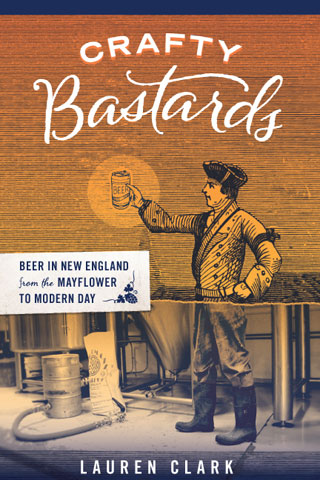Archive for June, 2010
June 27th, 2010
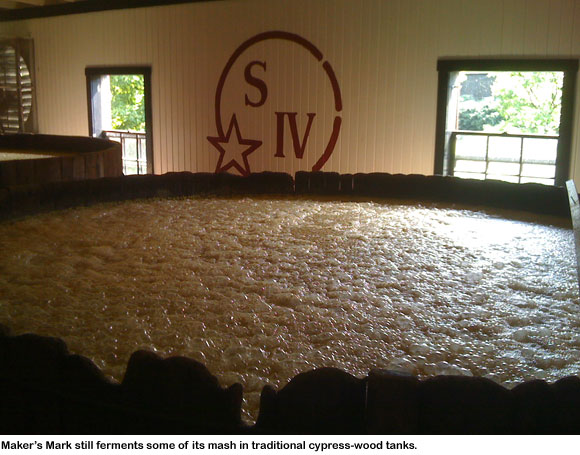
Here’s what I learned when I drank the Kentucky bourbon trail: 1. I like bourbon. 2. So do a lot of other people. The state’s 10 distilleries are well aware of this, of course. They’re priming for continued growth — not just in consumption, as more and more people around the world appreciate a fine, aged American whiskey, but also in tourism, as more and more people around the world start to view the triangle between Louisville, Frankfort and Bardstown like Napa Valley. That’s the idea, anyway.
First, some context about our most prized native spirit. Up until the turn of the millennium, bourbon, with a couple exceptions, had been in serious decline. It was an old-man drink, often with “old” right on the label. By 1997, consumption had fallen to fewer than 13 million cases, less than half bourbon’s total in 1980. But by 2009, the alignment of our aspirational taste for good food and drink with the advent of boutique bourbons had turned consumption back around to roughly 18.6 million cases and growing. That growth is driven both by the top-selling premium brands Jim Beam, Wild Turkey, Evan Williams and Maker’s Mark, and their high-end siblings like Booker’s, Eagle Rare and Van Winkle. (Jack Daniels, which is not a bourbon but a Tennessee whiskey, dwarfs all of these brands. A few years ago, it surpassed Johnny Walker Red as the world’s largest-selling single whiskey brand. But that’s another story.)

Some interesting tidbits about the bourbon world
- Everyone claims to be the oldest distillery. Don’t even try to keep track — it doesn’t matter. Distilling has been going on in Kentucky since it was settled in the 1700s, and chances are bourbon was being made on most of these sites, continuously or sporadically, for a very long time. By the way, there were hundreds of distilleries in the state before Prohibition. That fateful experiment, followed by World War II, industry consolidation and the U.S. shift in taste away from bourbon in the late 20th century, cut that number down to today’s 10.
- Everyone knows each other. Every time we left one distillery for another, we were told to “say hello to Al,” or “say hi to Jimmy for me.” And the old Kentucky distilling families are intertwined. Bill Samuels Jr. (of Maker’s Mark) and his sisters grew up playing with Beam kids, for instance, and the Beam family tree has branches that have touched many distilleries past and present. Notable among these is Heaven Hill, which has long been owned by the Shapira family but has employed three generations of Beams as master distillers.
- Most of Kentucky’s bourbon distilleries are owned by liquor conglomerates or large holding companies. That’s just the spirits business these days — don’t hold it against them.
- Bourbon may owe its life to Japan, Europe and Australia. These and a few other key countries accounted for a good chunk of bourbon’s market share during the stagnant years and have fueled its growth in the past 20 years or so.
- Here’s a handy cheat sheet on bourbon: what it is, its different flavor profiles, small-batch vs. single-barrel, etc.
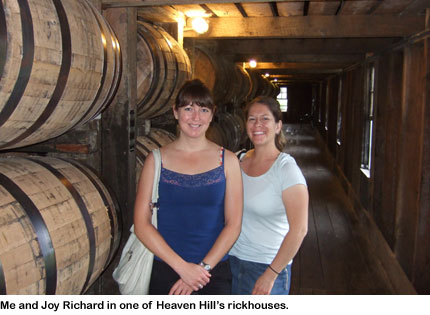
The trail
The official Kentucky Bourbon Trail was established by the Kentucky Distillers Association (KDA) in 1999. However, I refer to the unofficial bourbon trail, because not all Kentucky distilleries are part of the KDA and therefore aren’t listed on the official trail.
Joy Richard (aka Bourbon Belle of LUPEC Boston) of the Franklin Cafe, the Franklin Southie and the soon-to-open Citizen Pub, which will feature a whiskey bar, was my partner on this expedition. Like me, she enjoys asking geeky questions about bourbon by day and drinking bourbon by night. We unfortunately could not hit all of the distilleries in Kentucky. We missed Jim Beam, Woodford Reserve and the new Tom Moore distillery, along with the Oscar Getz Museum of Whiskey History in Bardstown. Hey, that gives us a few very good reasons to head back soon. Here’s a cheat sheet on the distilleries we visited, and their bourbons.
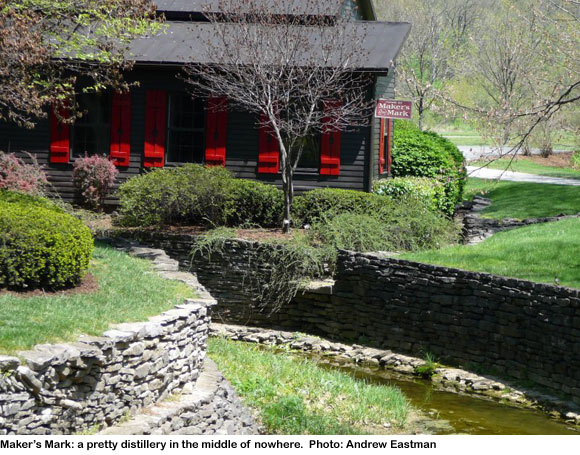
Maker’s Mark, Loretto
Owned by: Fortune Brands
Whiskies: Maker’s Mark, Maker’s 46
National Register of Historic Places
In a nutshell: The distillery’s storybook-like setting pretty much put bourbon tourism on the map, attracting over 90,000 visitors a year. Highlights: dipping my finger in various stages of sour mash fermenting in cypress-wood vessels that some Kentucky distilleries keep around for show (the bulk of fermentation happens in stainless steel now); tasting different stages of Maker’s Mark as it aged in the rickhouse; tasting the new Maker’s 46; learning that Marjorie Samuels, wife of the distillery’s founder, came up with the bourbon’s name and designed its label and red wax-sealed bottle.
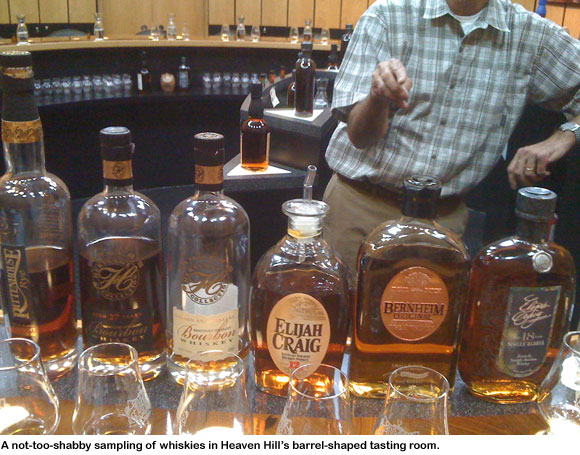
Heaven Hill, Bardstown, Louisville
Owned by: Heaven Hill Distilleries, Inc.
Whiskies include: Evan Williams, Elijah Craig, Parker’s Heritage Collection, Fighting Cock, Old Fitzgerald, Bernheim wheat whiskey, Rittenhouse rye whiskey, Pikesville rye whiskey.
In a nutshell: Heaven Hill’s huge rickhouses boast one of the largest inventories of aging whiskey in the world. The distillery upped the bourbon trail ante in 2004 when it opened its Bourbon Heritage Center in Bardstown, complete with a museum of bourbon history and barrel-shaped tasting room. Highlights: inhaling angel’s share in one of HH’s seven-story rickhouses; tasting rarities such as the 27-year-old Parker’s Heritage bourbon (an almost cognac-like exception to the rule that bourbon of such age tastes like wood chips) and 25-year-old Rittenhouse rye. Woohoo!

Four Roses, Lawrenceburg
Owned by: Kirin Brewing Co. Ltd.
National Register of Historic Places
Whiskies include: Four Roses Yellow, Small Batch, Single Barrel, Limited Edition and Mariage Collection.
In a nutshell: Very pretty (and unusual) Spanish mission-style buildings dating from 1910 house this distillery. Four Roses was one of the biggest-selling bourbons in the U.S. from the 1930s-1950s. Then its parent company, Seagrams, essentially took the brand to Japan, where it remained until the early 2000s. Now it’s making a deserved comeback. Highlights: learning about how Four Roses uses two mashbills (grain recipes) and five yeast strains to create different flavor profiles with which to blend its whiskies; tasting the deliciously dry Four Roses Single Barrel.
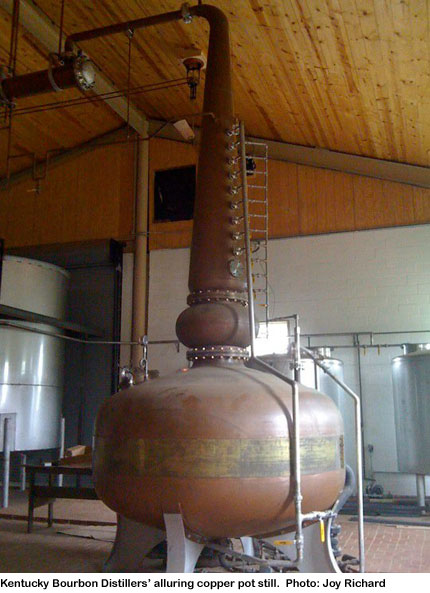
Kentucky Bourbon Distillers, Bardstown
Owned by: Kentucky Bourbon Distillers, Ltd.
Whiskies include: Black Maple Hill, Noah’s Mill, Rowan’s Creek, Willett, Johnny Drum
In a nutshell: Even Kulsveen, a Norwegian who married into the Willett family that established a distillery on this site after Prohibition, runs this boutique operation with his son, daughter and son-in-law. Finally nearing completion on a many-years-long rebuilding of the distillery, Kulsveen has built his reputation on blending great craft bourbons from casks procured from other distilleries. Highlights: getting an impromptu tour by the family behind this mysterious operation, including Kulsveen himself, who apparently is famous for his reclusivity.
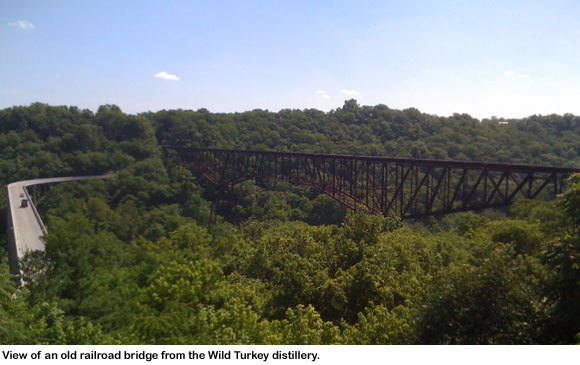
Wild Turkey, Lawrenceburg
Owned by: Gruppo Campari
Whiskies include: Wild Turkey 80 and 101, Rare Breed, Russell’s Reserve, Kentucky Spirit
In a nutshell: Mostly built in the 1930s, this romantically industrial distillery looks like something out of a promotional film for the WPA. A new distillery under construction will double Wild Turkey’s capacity. Highlights: seeing a load of corn spill out of the underbelly of a truck into an underground holding vessel before being conveyed up into tall silos; climbing to the top of the building that houses the tall column still and tasting the white dog (unaged whiskey) coming out of it before stepping onto a deck overlooking a cool, old railroad bridge.
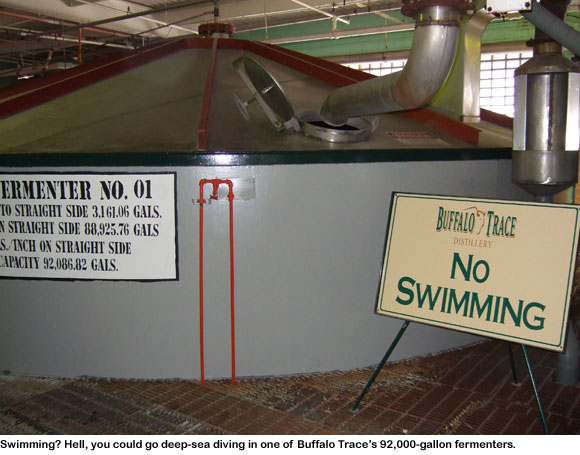
Buffalo Trace, Frankfort
Owned by: Sazerac Company, Inc.
Whiskies include: Buffalo Trace, Blanton’s, Sazerac, Eagle Rare, Van Winkle, W.L. Weller, Ancient Age
National Register of Historic Places
In a nutshell: Located on what was once an ancient buffalo trace, or crossing, on the banks of the Kentucky River, Buffalo Trace has several brick buildings dating back to the late 1800s. It is large but charming, and its visitors center features lots of great, old photos of bourbon distilling. Highlights: peering into the frighteningly deep 92,000-gallon, 1930s-era fermentation tanks; inhaling angel’s share in the distillery’s historic 1800s-era Warehouse C; witnessing the bottling of Blanton’s single-barrel destined for Australia.

Tags: bourbon, distilleries, Kentucky
Posted in Whiskey | 9 Comments »
June 19th, 2010

When Maker’s Mark president Bill Samuels Jr. and his master distiller, Kevin Smith, decided to make their company’s first new bourbon in over 50 years, they could have gone the well-traveled route: an extra-aged, high-proof whiskey with “reserve” in the name (and a price tag well over $50). But their whole philosophy goes against the whopping spice, caramel, smoke and tannic flavors that can come from extended time in charred oak barrels. They’re all about toasty, mellow, vanilla — a flavor profile they get by blending whiskey from barrels that rotate through three-story rickhouses (barrel-aging warehouses) for a “mere” six to eight years, compared to 12-20+ for some boutique bourbons. So, they decided to simply take their regular Maker’s Mark bourbon and amp it up it somehow. But how? Enter the wood chef.
I admit I laughed when I heard that term, too. (Disclosure: Maker’s Mark flew me down to Kentucky to check out the distillery.) But I realized it wasn’t a stretch when I talked to the chef himself, Brad Boswell of the Independent Stave Company. Boswell’s family has been making oak barrels for aging spirits and wine for 98 years. And lately, they have brought a healthy dose of science to their medieval craft. They begin with a thorough understanding of the chemical composition of different species of oak, and of the appropriate length of seasoning (aging oak staves in the open air) for the intended beverage. Then they cook the staves or finished barrels according to a library of recipes that “pinpoint layers of flavor” between toasted and charred, says Boswell. Basically, he can make you a barrel that imparts to its contents the exact characteristics you’re looking for.

In Maker’s Mark’s case, those characteristics were “sweet toasty oak, not smoky. Forward on the palate. Long finish. No sour or bitter aftertaste. A little spicy,” say my notes from a conversation with Smith. But the distiller knew that that particular combo of spicy notes and long finish typically go hand in hand with at least a bit of smokiness, sourness and bitterness. “We were asking for the impossible,” says Smith. In fact, they were asking for something that couldn’t be achieved with any sort of aging regime in the charred barrels that are standard to the bourbon industry. (The wood on the inside of the barrel is literally blackened with fire.)
It took 125 experiments — many of which “sucked,” says Smith — to hit upon the right wood recipe, one that was entirely new in bourbon making. It begins with French, rather than the standard American, oak staves. Those staves are seasoned for a long 18 months, which lowers the wood’s tannins and intensifies its vanillins. Boswell then tried a new cooking technique: he seared the staves on both sides, like a steak, to just short of charred. Boswell catalogued this recipe as Profile No. 46.
Smith arrayed 10 of the staves in an empty Maker’s barrel, then poured the fully matured bourbon back in to rest for about nine weeks. The combination of the seasoned French oak and Boswell’s searing method gave just the sweet toastiness and spicy notes — think cinnamon instead of rye bread — that Maker’s wanted. Samuels and Smith had their new product, and they decided to name it Maker’s 46, after Boswell’s special wood recipe.
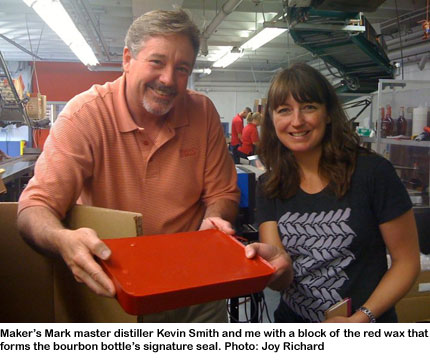
This may all sound pretty esoteric, but the result is a bourbon quite different from Maker’s Mark. The 46 has a dry spiciness, a rich texture and a higher proof (94 compared to 90 for the flagship) that are sure to appeal to the bourbon, and even rye, adventurer, without alienating the devoted Maker’s Mark drinker. And it’s reasonably priced at about $10 more than traditional Maker’s, which is usually $23 to $25. Maker’s 46 will be available in Boston sometime next month.
The 70-year-old Samuels, a seventh-generation distiller who is nearing retirement, seems pleased by the new whiskey. He admits that it arose partly out of market demand for something new and exciting from Maker’s, which largely created the premium bourbon category that is now exploding. But he also wanted to be remembered for something other than faithfully reproducing his father’s bourbon recipe from the 1950s. Now his nightmares of a tombstone that says, simply, “He didn’t screw it up,” are over.
Coming up: my tour of the Kentucky bourbon trail.
Tags: Bill Samuels Jr., bourbon, Brad Boswell, Kentucky, Kevin Smith, Maker's 46, Maker's Mark
Posted in Booze in the news, Whiskey | 8 Comments »
June 13th, 2010
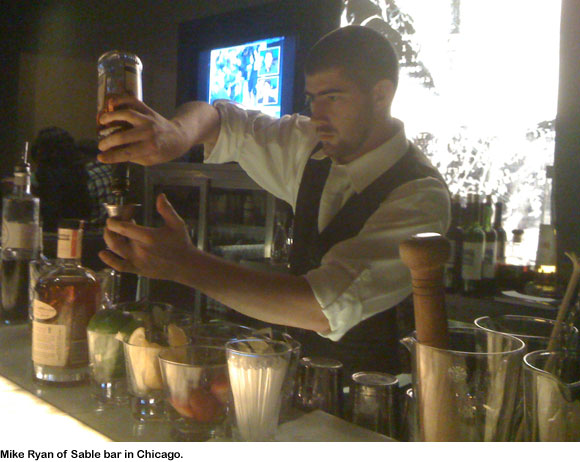
I couldn’t resist spending a night in Chicago for a taste of the bar scene before continuing on to Kentucky for my first excursion on the bourbon trail. I hit up a storied tavern and two craft cocktail bars. It was a fine whistle-whetting that only left me thirsting for more.
Billy Goat Tavern. Why I had never been informed of this place I have no idea. I was beckoned here by a large “Billy Goat Tavern” sign on a Michigan Ave. overpass, then another that said “Cheezborger, cheezborger, cheezborger” and something about this being the birthplace of the 1970s Saturday Night Live skit that also brought us the catchphrase, “No Coke, Pepsi.” The dark doorway looked a bit sketchy, but I bet that there was a gem awaiting me on the inside, and I was right. The tavern moved to its current location in 1964 and appears not to have changed since. One side of the room is a diner, the other side a bar. A formica bar. With Schlitz on tap. And a bartender who has worked there for a really long time. He told me about how the tavern became a shrine to the Cubs, and how it was a hangout for hard-drinking newspapermen back when there was such a thing. Luckily, no one seemed to think it was an abomination when I set my laptop on the bar to get a bit of work done. In fact, the regular sitting next to me said in a tone of pleasant surprise, “They have wi-fi here?”

Sable Kitchen & Bar. New, sleek spot next to the Palomar Hotel with a futuristic glowing service bar and LCD screen playing a roaring fire. Mike Ryan, formerly of the Violet Hour, was tending bar that night. With an understated, gentlemanly manner, a sweet smile and a tattoo of bacon strips on his forearm, Ryan mixed a strong Ti Punch (La Favorite rhum agricole, cane syrup, limes) and then poured a flight of unusual and tasty whiskies, including Templeton rye from Iowa, Amrut single malt “scotch” from India and a “white dog” (unaged whiskey) made from spelt at Chicago’s Koval distillery. Sable boasts some superlative bar snacks, including BLT sliders where the B is (pork) belly.

Violet Hour. You take a cab a little way out of downtown, past what’s left of the infamous Cabrini-Green housing project, and look for an unmarked door on North Damen Ave. Wow, is this a romantic spot. Even if great classic and classic-inspired cocktails could not be found here, it would be worth spending an evening swathed in the dusty-violet aura of this sort of Gilded Age parlor gone minimalist. It gets its name and concept from the oft-quoted-in-cocktail-circles The Hour by Bernard DeVoto (which, coincidentally, has just been re-published): “This is the violet hour, the hour of hush and wonder, when the affections glow again and valor is reborn, when the shadows deepen magically along the edge of the forest and we believe that, if we watch carefully, at any moment we may see the unicorn.”
After my delicious Hush and Wonder (Methusalem rum, creme de violette, fresh lime, grapefruit bitters), I saw no unicorns, but I did see a night in my future when I’d return to Chi-Town for some more quality drinking.
Tags: Billy Goat Tavern, Sable Kitchen & Bar, Violet Hour
Posted in Chicago, Rum, Whiskey | No Comments »
June 9th, 2010
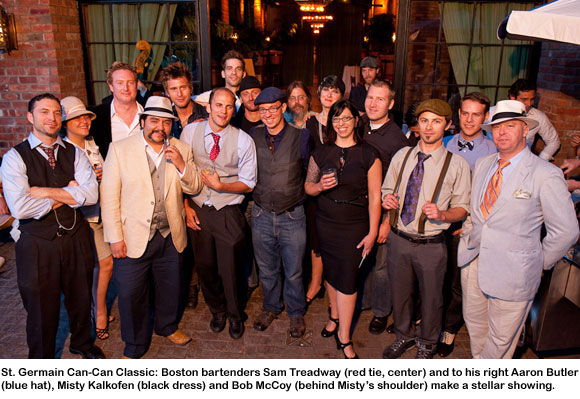
Four Boston bartenders competed in yesterday’s third annual St. Germain Can-Can Classic at the Bowery Hotel in New York City, and two of them took home the top two prizes. Congrats to Bob McCoy of Eastern Standard for his 1st place, $5K win and to Misty Kalkofen of Drink for her 2nd place, $2K win.
Three cheers as well to competitors Aaron Butler of Russell House Tavern and Sam Treadway of Drink for rounding out Boston’s prowess in this mixology event. Each of the four bartenders became eligible to compete in the Can-Can by winning St. Germain’s monthly cocktail contests.
McCoy, who also employed the elderflower liqueur to great effect at drinkboston’s Bartenders on the Rise event, impressed this year’s Can-Can judges with the mixture below. More recipes and tidbits to come as I get them.
Elixir Alpestre
By Bob McCoy
2 oz Bols Genever
3/4 oz St. Germain
1/4 oz Becherovka
1 dash Angostura Orange Bitters
6 drops Pernod Absinthe
Combine all ingredients in a mixing glass, add ice and stir. Strain into a coupe glass and garnish with a lemon twist.
Tags: Aaron Butler, Bob McCoy, cocktail competition, Misty Kalkofen, Sam Treadway, St. Germain
Posted in Bartenders, Cocktails, Liqueur | 5 Comments »
June 3rd, 2010

The latest happenings in and thoughts on Boston’s world of drink… First, ‘bad guy’ cocktails. OK, two cocktails does not make a trend, but maybe more will follow from this post, and then we’ll have conveniently manufactured one. (I love social media!) What I’m getting at are Eastern Standard‘s Frobisher and the Starlite Lounge‘s Tony Montana.
I was delighted when Jackson Cannon, who, like me, is a devotée of the FX series Damages, told me he was naming a new cocktail on the menu after Arthur Frobisher, the Enron-inspired CEO played by Ted Danson. Frobisher stands out as a bad guy in a show populated almost entirely by bad guys (and girls — the protagonist is the ruthless high-stakes litigator Patty Hewes, played by Glenn Close). That’s because Danson has elevated playing an unmitigated tool to a high art form. Cannon celebrates that achievement with a stirred, straight-up mixture of 2 oz Oxley gin, 3/4 oz ES’ own rose vermouth, 1/4 oz Luxardo maraschino liqueur, orange oil and a Luxardo cherry.
Then there’s the Tony Montana, which Beau Sturm is known to serve while uttering its name in the Cuban accent with which Al Pacino menaces his way through the gangster training video Scarface. The recipe: 2 oz Pyrat rum, 3/4 oz Carpano Antica, 1 barspoon Benedictine and 1 dash orange bitters, stirred well and strained. The thing about these drinks is that they’re not just ridiculous concoctions slapped with a badass name to get people to drink them. The cocktails themselves are badass — all spirits, straight up, not to be trifled with. Never mind that both Frobisher’s and Montana’s substance of choice is powdery and white, not fiery and wet.
» Stoddard’s (48 Temple Place). My first impressions are pretty positive. The place looks beautiful, with its brick walls, massive, century-old bar imported from England, prints of old Boston, and local artifacts including old street lamps and corsets from an early incarnation of the Stoddard’s space (before its days as a cutlery shop of the same name). The lamb sausage sandwich and the steak frites over braised oxtail were really good, as was our bar service by Jamie Walsh. The Gin Sling and Stone Sour, both tall drinks over ice, were well made, but the Brandy Crusta was a bit watered down, and the Pegu Club was out-of-whack — too heavy on the Plymouth gin and without Angostura bitters to balance the orange flavors, as Stoddard’s house recipe strangely dictates.
We were fortunate to get a peek at the already infamous, not-yet-open private club downstairs. For a membership fee of $2,000, you get your own key and entrance (in the Winter Place alleyway right next to Locke-Ober) to this low-lit den, plus privileges to use the space for meetings and parties. Stoddard’s was taken to task several months before it opened when a rumor circulated that the club would be men-only. That’s not the case, although Stoddard’s seems to really, really want to skew its demo to recreate a late-19th-century gentlemen’s bar, albeit with TVs. The bar staff appears to be entirely male, and General Manager Billy Lyons said that while membership for the private club is building, only two women have bought in so far.
» If, the next time you go to Drink in Fort Point, you notice a lot more Europeans than usual, blame John Gertsen. He recently traveled to the 2010 Cocktails Spirits expo in Paris as the representative of an American cocktail bar. He gave a well-received presentation about his landmark bar, including a demo of the Chee Hoo Fizz, a cocktail invented by Randy Wong of the exotica orchestra Waitiki, which spearheaded Drink’s now famous summer Sunday tiki nights. While at the expo, Gertsen also encountered a bunch of rare spirits like Portuguese tequila from 1920 and a 1917 vipérine — booze flavored with a big, ol’ poisonous snake. Here’s a video of a good chunk of John’s presentation, and here’s another one of him and fellow Boston barman Scott Holliday (of Rendezvous) looking at the vipérine and other rare liquids with spirits collector George Dos Santos. (Thanks to Jörg Meyer of Le Lion Bar in Hamburg, Germany, for those videos.) Congrats, John!
» Citizen Public House & Oyster Bar. A new outpost of the growing Franklin South End/Franklin Southie empire, the Citizen will open on Boylston St. overlooking Fenway Park in July. Joy Richard, whom drinkboston has mentioned several times as a cocktail contest winner and founding member of LUPEC Boston, will oversee the bar as she does at the other two restaurants. Expect good cocktails, beer and wine but, most important of all, a whiskey bar! In fact, Joy and I happen to be heading to Kentucky next week to visit several distilleries along the Bourbon Trail, starting with Maker’s Mark and a tasting of its new whiskey, Maker’s 46. I’ll be sending regular communiqués via Twitter from that jaunt. Until then…
Tags: Arthur Frobisher, Bourbon Trail, Chee Hoo Fizz, Citizen Pub, Damages, john gertsen, Paris Cocktails Spirits, Scarface, Stoddard's, Ted Danson, Tony Montana
Posted in Boston bars, Cocktails, Gin, Nips, Rum, Whiskey | 10 Comments »


















